| |
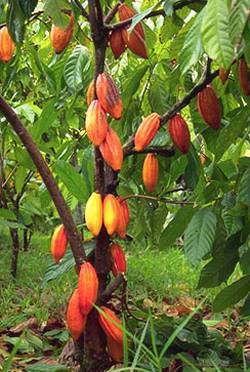
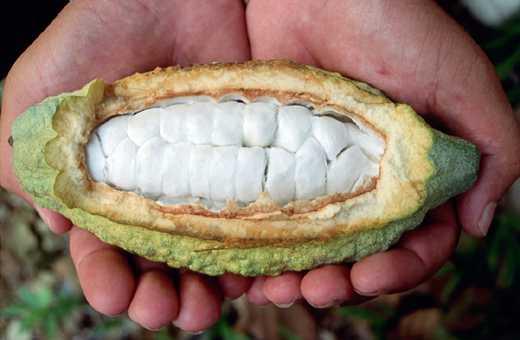
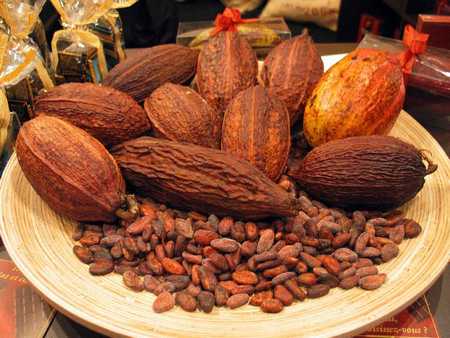
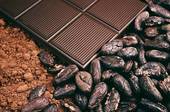
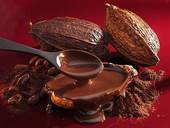
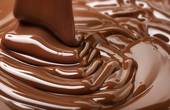
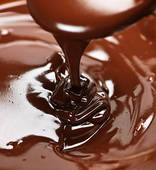
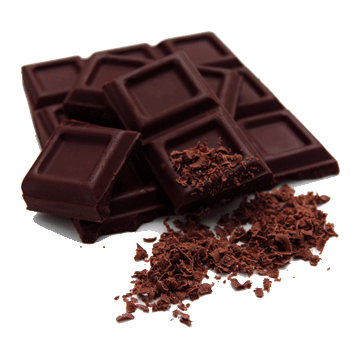
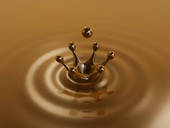
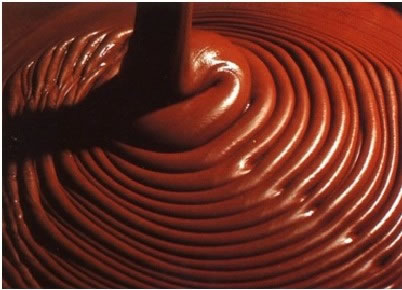
|
|
PRODUCTION PROCESS
From the cocoa bean to the finished product. Cocoa is the fruit of a plant (Theobroma cacao) grown in the tropical zone.
The plants of cocoa come from different races: the Criollo, precious plants of Venezuela, Colombia and Mexico, with beans (cotyledons) round, clear (white and pink), sweet flavor with a slightly bitter.
Forastero is the original high amazon, beans with a little 'flatter, with purple taste strong and bitter, thick skin, with higher content of tannins. The production capacity is greater than that of the Criollo.
The tree of chocolate. The cacao tree is delicate and fragile. Needs protection from the wind and, in most cases, a good shelter from the sun, especially during the period from two to four years.
A seedling newborn is usually found shelter in the shade of banana trees, coconut palms and plantains. But when they grew up, the tree can live in full sun, as long as living in areas with fertile soil
The tree has a trunk thin, very decorative foliage that goes through all the shades of red, brown and bronze. In the wild also reaches 10 meters, but for ease of harvest, in the plantations was held on 5/6 feet tall.
The trees bloom from the age of 2-3 years, but only a small percentage (between 1 and 5%) is pollinated.
The trees begin to bear fruit (pods) when they are three / five years of age.
Bloom throughout the year and the fruits are harvested twice a year, before and after the rainy season: the main crop and the secondary, with fruits of inferior quality. Normally the harvest takes place in periods that vary widely from year to year depending on climatic conditions, often in the same regions. Recognize the achievement of fruit ripening is the result of experience and training.
The collection. The fruit of the cocoa is opened with a sharp blow of a machete (a good farmer is able to open up to 500 fruits per hour), can cleave the shell as hard as leather.
Fermentation. Are extracted from the seeds, usually forty (cocoa beans) wrapped in a whitish mucilage composed of sugars.
The cluster is put into wooden troughs, baskets, or wrapped in banana leaves and put under ground, depending on the area, so that we can start the fermentation, a process of "rising" durnate which the temperature is maintained between 40 and 50 ° C and wherein the sugars contained in the beans are transformed into acids, mainly lactic acid and acetic acid.
The end result will be that you have eliminated the residual pulp and have reduced the bitter and astringent taste of the beans, as well as to have developed the essential oils. To obtain a good fermentation, the beans are rotated every day.
After a period ranging from three (for some varieties of Criollo) to 5/6 days, during which the temperature quickly reaches the 40 sometimes 50 degrees, the fermentation took place, bacteria and yeasts have started the production of the precursors of 500 flavors in cocoa.
Drying. Like any fruit that contains moisture, the beans to be stored must undergo a drying process.
In some countries, the cocoa is simply lying in the sun on mats or on special "drawer" that are collected inside in case of rain. Where instead the humid climate does not allow drying in the sun, using methods of artificial, mainly constituted by flows of hot air.
In case of favorable weather, the drying process takes several days, during which farmers mix the beans to obtain a homogeneous result, while eliminating any foreign bodies or cocoa waste.
Result of this process is that the beans have lost about half of their weight and are called "green cocoa."
Shipping. The beans are then put into jute bags and shipped to distribution centers, where buyers will go to inspect the product, testing a sample.
The storage takes place under strict and controlled to prevent the cocoa, which absorbs odors like a sponge, is in contact with the substances unpleasant.
Toast. The beans are shipped to places where they are roasting clean from any impurities, mixed (only a few are manufacturers of CRU, or chocolate derived from a single plant species) and roasted for a period which varies from manufacturer to manufacturer depending on the result final one wants to obtain.
A toasting wrong or excessive, can cause problems irremediable to the final result giving the cocoa a strong bitterness which, together excessive acidity and astringency, is one of the defects of the chocolate.
The milling. The roasted cocoa so passes into the millstones that break the beans and remove the skins, getting the cocoa nib, a compound that contains about 54% cocoa butter and 46% of the "lean", still containing 8 26% of butter, cocoa cake or the panel.
The next step is that of "grinding" of cocoa, that actually grinding is not because the cocoa melts during this operation (the cocoa butter melts at 34 ° C) into particles of 100 microns, resulting in the so-called "mass "or" cocoa "or" liquor ". From here it passes to refining in which the particles are reduced in the order of 25-30 microns and it has the possible addition of further cocoa butter.
The addiction of lecithin. Soy lecithin is a key ingredient in the production of chocolate.
Its addition has the fundamental purpose of emulsifying the traces of moisture present in the chocolate with the lipid part, and, by lowering the viscosity, increases the fluidity of the chocolate.
thanks to this last feature, the lecithin allows to operate a conching at lower temperatures, improving the development of the aroma of chocolate.
Lecithin can also help reduce the effect called in jargon "blooming" (outcrop) of cocoa butter.
Conching.
The product thus obtained, after the addition of the ingredients needed for the processing in chocolate, will then pass to the "conching", that is through a machine that slamming the liquid on the walls, facilitates the spillage from the product of part acidic materials, but does not changes aromas.
The tempering. The tempering is used to obtain a chocolate on the physical characteristics well-defined and long lasting, thanks to which the product can be preserved for a long time.
to do this it is necessary a crystallization dle cocoa butter crystals in stable form. The cocoa butter has in fact the characteristic of solidification in different types of crystals.
The purpose of tempering is to solidify the cocoa butter orienting the crystallization in a stable form to avoid then the crystals which with the passing of time escape resulting in bleaching of the chocolate bars.
The chocolate that comes out of "conching" at a temperature of about 40 degrees, then passes into the tempering that lowers (in the case of the dark) the temperature to 28 ° and then bring it back to 31.
The thermal shock suffered by the product greatly reduces the number of stable crystals of cocoa butter: With this process, the chocolate will gain in luster, durability and consistency.
The liquid chocolate is then poured into steel molds which are made to advance on a tape subjected to continuous vibration in order to eliminate possible air bubbles inside the product.
The chain automatically closes the mold and then, by means of an automatic piston, insert the same in the centrifuge.
The centrifuge through constant vibration allows to mix the chocolate mold.
The mold is cooled and brought to a temperature of 10 °, to then be able take the form later.
A person employed at the stage of demoulding, the mold opens and disconnects the product from the mold.
TYPES OF CHOCOLATE
Dark chocolate. Dark chocolate has more cocoa aroma and contains the highest percentage. It must have a minimum percentage of cocoa by 35% and may go up to 99%. The higher the cocoa content, the more intense the flavor. Until not long ago, a chocolate with only 35% cocoa was appreciated by the majority of the population. But our palates were then evolved, and now we are able to select and better appreciate the flavors bolder, coming to fully understand the levels of cocoa by 70% or more. Dark chocolates of high quality and with high levels of cocoa naturally have lower content of sugar. It is present only in the amount necessary to strengthen the intensity of the pleasant taste of cocoa. Dark chocolate can also be an ingredient for desserts.
Milk chocolate. The milk was added for the first time to the chocolate in the second half of the 800. Milk chocolate is undoubtedly the most popular recipe from children.
A quality product is obtained from cocoa beans roasted and refined and milk powder. Prepared from fresh milk of high quality with a particular drying process.
This mixture is kneaded until a homogeneous mass to develop. The mass is then refined until the particles become very small. The first step to obtain a homogeneous paste and delicate is now complete, but the cocoa mass has not yet revealed all its full, distinctive aroma. E 'at this point comes the most important process: the process of conching.
White chocolate. White chocolate is prepared exclusively with cocoa butter-quality, more milk and sugar. Unlike the dark chocolate contains no cocoa mass. Its taste is pleasantly sweet goodies that meets both adults and children.
Chocolate gianduia. The authorship of this type of chocolate is Turin. In 1806, cocoa had a high cost and some thought to mix chocolate with hazelnuts from Piedmont, reduced to powder. Was obtained as a chocolate very tasty and cheaper. The chocolate gianduja, which may be dark or milk, contains about 30% cocoa and 20-40 g of ground hazelnuts for every 100 g of product.
NB: These delicate cocoa mixes you can add fragrant dried fruit, cereal, puffed rice and spices in order to obtain exquisite delights of chocolate.
Conservation. Chocolate should be stored in a cool, dry place (18-22 ° C), not exposed to direct sunlight and not in the refrigerator or near aromatics. The cocoa butter, in fact, absorb odors very easily.
Nutritional. The chocolate brings about 500-600 Kcal per 100 g of product, and for this was considered a food of high energy value with a good degree of assimilation. Among the components there is also the theobromine, substance from properties analogous to those of caffeine. In the seventies the chocolate suffered a slump in popularity, because liable to cause weight gain and cholesterol as well as the onset of caries. The result was the mistaken belief that "food of the gods" was dangerous! Today, fortunately, these stereotypes have been proven wrong by nutritionists, who, on the contrary, they suggest placing it in the daily diet, with one recommendation: do not abuse it!
The chocolate, in fact, is ideal for those suffering from low blood pressure due to the presence of potassium and is useful for subjects anemic thanks to good percentage of iron. Can also be eaten by children, because it does not cause digestive problems and be inserted in their diet as long as no earlier than 2/3 years.
CLICK HERE TO WATCH THE EVOLUTIVE PROCESS OF THE CHOCOLATE
|